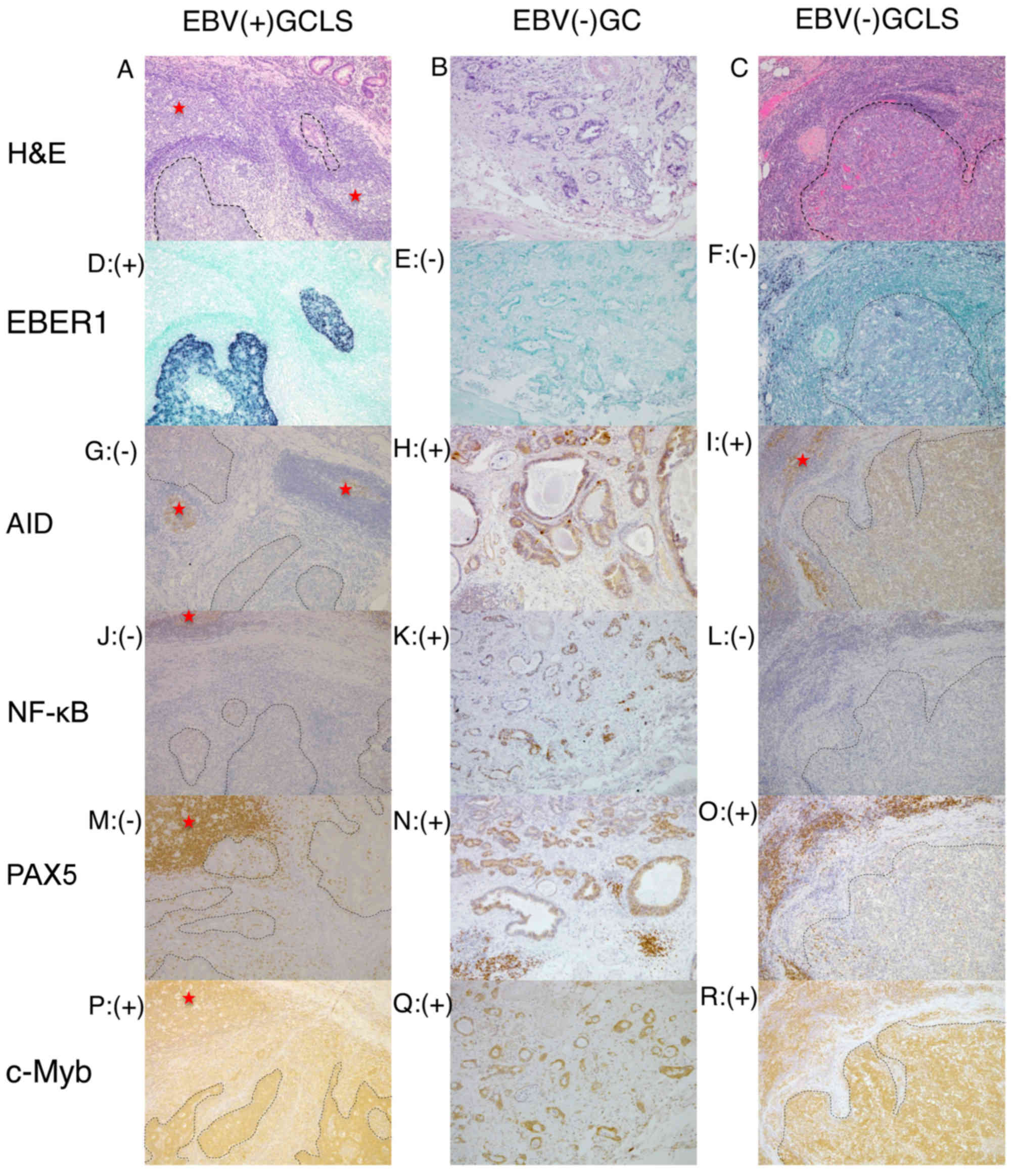|
1
|
Jha HC, Banerjee S and Robertson ES: The
role of Gammaherpesviruses in cancer pathogenesis. Pathogens.
5(pii): E182016. View Article : Google Scholar : PubMed/NCBI
|
|
2
|
Epstein MA, Achong BG and Barr YM: Virus
particle in cultured lymphoblasts from Burkitt's Lymphoma. Lancet.
1:702–703. 1964. View Article : Google Scholar : PubMed/NCBI
|
|
3
|
Shinozaki-Ushiku A, Kunita A and Fukayama
M: Update on Epstein-Barr virus and gastric cancer (review). Int J
Oncol. 46:1421–1434. 2015.PubMed/NCBI
|
|
4
|
Lim H, Park YS, Lee JH, Son da H, Ahn JY,
Choi KS, Kim do H, Choi KD, Song HJ, Lee GH, et al: Features of
gastric carcinoma with lymphoid stroma associated with Epstein-Barr
virus. Clin Gastroenterol Hepatol. 13:1738–1744.e2. 2015.
View Article : Google Scholar : PubMed/NCBI
|
|
5
|
Chiba T, Marusawa H and Ushijima T:
Inflammation-associated cancer development in digestive organs:
Mechanisms and roles for genetic and epigenetic modulation.
Gastroenterology. 143:550–563. 2012. View Article : Google Scholar : PubMed/NCBI
|
|
6
|
Marusawa H, Takai A and Chiba T: Role of
activation-induced cytidine deaminase in inflammation-associated
cancer development. Adv Immunol. 111:109–141. 2011. View Article : Google Scholar : PubMed/NCBI
|
|
7
|
Shimizu T, Marusawa H, Endo Y and Chiba T:
Inflammation-mediated genomic instability: Roles of
activation-induced cytidine deaminase in carcinogenesis. Cancer
Sci. 103:1201–1206. 2012. View Article : Google Scholar : PubMed/NCBI
|
|
8
|
Zan H and Casali P: Regulation of Aicda
expression and AID activity. Autoimmunity. 46:83–101. 2013.
View Article : Google Scholar : PubMed/NCBI
|
|
9
|
Honjo T, Kobayashi M, Begum N, Kotani A,
Sabouri S and Nagaoka H: The AID dilemma: Infection, or cancer? Adv
Cancer Res. 113:1–44. 2012. View Article : Google Scholar : PubMed/NCBI
|
|
10
|
Kawata S, Yashima K, Yamamoto S, Sasaki S,
Takeda Y, Hayashi A, Matsumoto K, Kawaguchi K, Harada K and
Murawaki Y: AID, p53 and MLH1 expression in early gastric neoplasms
and the correlation with the background mucosa. Oncol Lett.
10:737–743. 2015.PubMed/NCBI
|
|
11
|
Dixon MF, Genta RM, Yardley JH and Correa
P: Classification and grading of gastritis. The updated Sydney
System. International Workshop on the Histopathology of Gastritis,
Houston 1994. Am J Surg Pathol. 20:1161–1181. 1996. View Article : Google Scholar : PubMed/NCBI
|
|
12
|
Iwasaki T, Matsushita M, Nonaka D, Nagata
K, Kato M, Kuwamoto S, Murakami I and Hayashi K: Lower expression
of CADM1 and higher expression of MAL in Merkel cell carcinomas are
associated with Merkel cell polyomavirus infection and better
prognosis. Hum Pathol. 48:1–8. 2016. View Article : Google Scholar : PubMed/NCBI
|
|
13
|
Takashima K, Ohashi M, Kitamura Y, Ando K,
Nagashima K, Sugihara H, Okuno K, Sairenji T and Hayashi K: A new
animal model for primary and persistent Epstein-Barr virus
infection: Human EBV-infected rabbit characteristics determined
using sequential imaging and pathological analysis. J Med Virol.
80:455–466. 2008. View Article : Google Scholar : PubMed/NCBI
|
|
14
|
Meyerson M, Gabriel S and Getz G: Advances
in understanding cancer genomes through second-generation
sequencing. Nat Rev Genet. 11:685–696. 2010. View Article : Google Scholar : PubMed/NCBI
|
|
15
|
Matsumoto Y, Marusawa H, Kinoshita K, Endo
Y, Kou T, Morisawa T, Azuma T, Okazaki IM, Honjo T and Chiba T:
Helicobacter pylori infection triggers aberrant expression of
activation-induced cytidine deaminase in gastric epithelium. Nat
Med. 13:470–476. 2007. View
Article : Google Scholar : PubMed/NCBI
|
|
16
|
Goto A, Hirahashi M, Osada M, Nakamura K,
Yao T, Tsuneyoshi M, Takayanagi R and Oda Y: Aberrant
activation-induced cytidine deaminase expression is associated with
mucosal intestinalization in the early stage of gastric cancer.
Virchows Arch. 458:717–724. 2011. View Article : Google Scholar : PubMed/NCBI
|
|
17
|
Le Negrate G: Viral interference with
innate immunity by preventing NF-κB activity. Cell Microbiol.
14:168–181. 2012. View Article : Google Scholar : PubMed/NCBI
|
|
18
|
de Souza CR, de Oliveira KS, Ferraz JJ,
Leal MF, Calcagno DQ, Seabra AD, Khayat AS, Montenegro RC, Alves
AP, Assumpção PP, et al: Occurrence of Helicobacter pylori and
Epstein-Barr virus infection in endoscopic and gastric cancer
patients from Northern Brazil. BMC Gastroenterol. 14:1792014.
View Article : Google Scholar : PubMed/NCBI
|
|
19
|
Shimizu T, Marusawa H, Matsumoto Y,
Inuzuka T, Ikeda A, Fujii Y, Minamiguchi S, Miyamoto S, Kou T,
Sakai Y, et al: Accumulation of somatic mutations in TP53 in
gastric epithelium with Helicobacter pylori infection.
Gastroenterology. 147:407–417.e3. 2014. View Article : Google Scholar : PubMed/NCBI
|
|
20
|
Li X, Cheung KF, Ma X, Tian L, Zhao J, Go
MY, Shen B, Cheng AS, Ying J, Tao Q, et al: Epigenetic inactivation
of paired box gene 5, a novel tumor suppressor gene, through direct
upregulation of p53 is associated with prognosis in gastric cancer
patients. Oncogene. 31:3419–3430. 2012. View Article : Google Scholar : PubMed/NCBI
|
|
21
|
Shetzline SE, Rallapalli R, Dowd KJ, Zou
S, Nakata Y, Swider CR, Kalota A, Choi JK and Gewirtz AM:
Neuromedin U: A Myb-regulated autocrine growth factor for human
myeloid leukemias. Blood. 104:1833–1840. 2004. View Article : Google Scholar : PubMed/NCBI
|
|
22
|
Cancer Genome Atlas Research Network, .
Comprehensive molecular characterization of gastric adenocarcinoma.
Nature. 513:202–209. 2014. View Article : Google Scholar : PubMed/NCBI
|
|
23
|
Abe H, Kaneda A and Fukayama M:
Epstein-barr virus-associated gastric carcinoma: Use of host cell
machineries and somatic gene mutations. Pathobiology. 82:212–223.
2015. View Article : Google Scholar : PubMed/NCBI
|
|
24
|
Camargo MC, Kim WH, Chiaravalli AM, Kim
KM, Corvalan AH, Matsuo K, Yu J, Sung JJ, Herrera-Goepfert R,
Meneses-Gonzalez F, et al: Improved survival of gastric cancer with
tumour Epstein-Barr virus positivity: An international pooled
analysis. Gut. 63:236–243. 2014. View Article : Google Scholar : PubMed/NCBI
|











